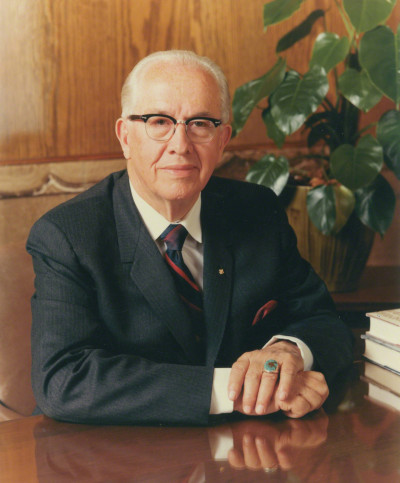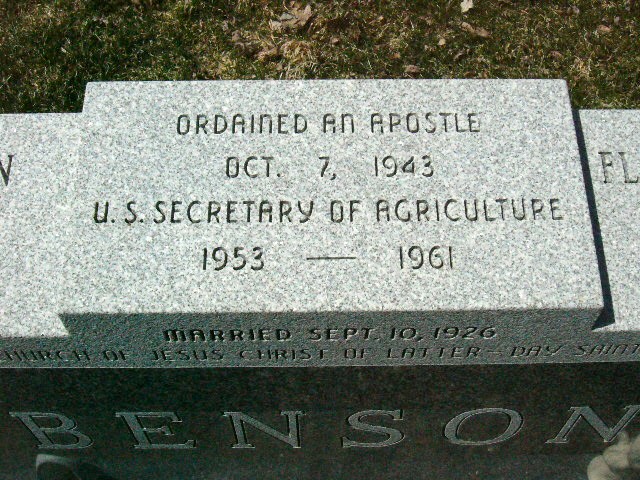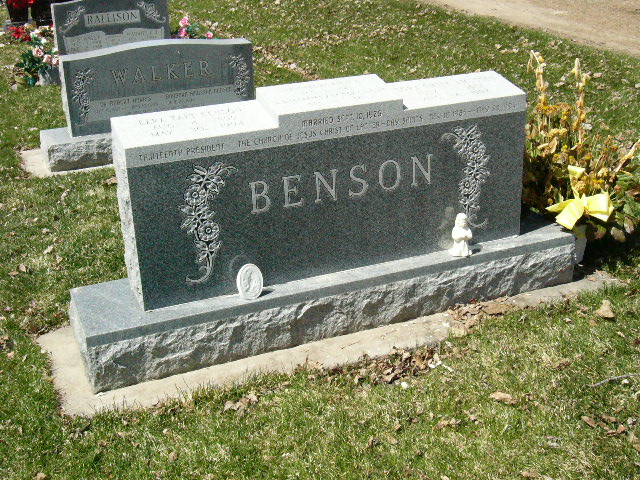Ezra Taft Benson (Ezra Taft Benson)

Born on a farm in Whitney, Idaho, Benson was the oldest of eleven children. He was the great-grandson of Ezra T. Benson, who was appointed by Brigham Young a member of the Quorum of the Twelve Apostles in 1846. Benson began his academic career at Utah State Agricultural College (USAC), where he first met his future wife, Flora Smith Amussen. Benson alternated quarters at USAC and work on the family farm. Benson served an LDS Church mission in Britain from 1921 to 1923. It was while serving as a missionary, particularly an experience in Sheffield, that caused Benson to realize how central the Book of Mormon was to the Restored Gospel message and converting people to the LDS Church. On his mission, he served as president of the Newcastle Conference. After his mission, Benson studied at Brigham Young University and finished his bachelor’s degree there in 1926. That year he married Flora Smith Amussen, shortly after her return from a mission in Hawaii. They became the parents of six children. Benson received his master’s degree from Iowa State University. Several years later, he did preliminary work on a doctorate at the University of California at Berkeley, but never completed it.
Just after receiving his master’s degree, Benson returned to Whitney to run the family farm. He later became the county agriculture extension agent for Oneida County, Idaho. He later was promoted to the supervisor of all county agents and moved to Boise in 1930. While in Boise, Benson also worked in the central stake extension office connected with the University of Idaho Extension Service. He also founded a farmers cooperative. Benson was superintendent of the Boise Stake Young Men’s Mutual Improvement Association and later a counselor in the stake presidency. In 1939, he became president of the Boise Idaho Stake. Later that year, he moved to Washington, D.C., to become Executive Secretary of the National Council of Farmer Cooperatives, and became the first president of a new church stake in Washington. In August 1989, Benson received the Presidential Citizens Medal from President George H. W. Bush.
In 1943, Benson went to Salt Lake City to ask church leaders for advice on whether to accept a new job. They unexpectedly told him that he would join them. On October 7, 1943, both Benson and Spencer W. Kimball (1895–1985) became members of the church’s Quorum of the Twelve Apostles, filling two vacancies created by the deaths of apostles that summer. Because Kimball was older than Benson and was therefore ordained first, he was given seniority over Benson in the Quorum. Upon Kimball’s death in 1985, Benson became the president of the church in his place. In 1948, Republican presidential nominee Thomas E. Dewey approached Benson before the election that year about becoming the United States Secretary of Agriculture. Although Benson had supported his distant cousin Robert A. Taft over Dwight D. Eisenhower for the 1952 Republican nomination and did not know Eisenhower, after his election Eisenhower nevertheless appointed Benson as Secretary of Agriculture. Benson accepted with the permission and encouragement of church president David O. McKay; Benson therefore served simultaneously in the United States Cabinet and in the Quorum of the Twelve Apostles.
Benson opposed the system of government price supports and aid to farmers which he was entrusted by Eisenhower to administer, arguing that it amounted to unacceptable socialism. Nonetheless, he served in his cabinet position for all eight years of Eisenhower’s presidency. He was selected as the administrator-designate of the Emergency Food Agency, part of a secret group that became known as the Eisenhower Ten. The group was created by Eisenhower in 1958 to serve in the event of a national emergency. Benson was an outspoken opponent of communism and socialism, and a supporter, but not a member, of the John Birch Society, which he praised as “the most effective non-church organization in our fight against creeping socialism and Godless Communism.” He published a 1966 pamphlet entitled “Civil Rights, Tool of Communist Deception”. In a similar vein, during a 1972 general conference of the LDS Church, Benson recommended that all members of the church read Gary Allen’s New World Order tract “None Dare Call it A Conspiracy”.
Benson succeeded Kimball as President of the Quorum of the Twelve Apostles in 1973, and as church president in 1985. During his early years as church president, Benson brought a renewed emphasis to the distribution and reading of the Book of Mormon, reaffirming this LDS scripture’s importance as “the keystone of [the LDS] religion.” He is also remembered for a general conference sermon condemning pride. Benson was a lifelong supporter of Scouting. He started in 1918 as assistant Scoutmaster. On May 23, 1949, he was elected a member of the National Executive Board of the Boy Scouts of America. He received the three highest national awards in the Boy Scouts of America—the Silver Beaver, the Silver Antelope, and the Silver Buffalo—as well as world Scouting’s international award, the Bronze Wolf.
Benson suffered poor health in the last years of his life from the effects of blood clots in the brain, dementia, strokes, and heart attacks, and was rarely seen publicly in his final years. He was hospitalized in 1992 and 1993 with pneumonia. Benson died May 30, 1994, of congestive heart failure in his Salt Lake City apartment at the age of 94. Funeral services were held June 4, 1994, in the Salt Lake Tabernacle and conducted by Gordon B. Hinckley. He was buried near his birthplace in Whitney, Idaho, at the Whitney City Cemetery. Howard W. Hunter succeeded Benson as LDS Church president.
Born
- August, 04, 1899
- USA
- Whitney, Idaho
Died
- May, 30, 1994
- USA
- Salt Lake City, Utah
Cause of Death
- congestive heart failure
Cemetery
- Whitney Cemetery
- Whitney, Idaho
- USA



